Mostrar el registro sencillo del ítem
Monetary policy in the grip of a pincer movement
| dc.contributor.author | Borio, Claudio | |
| dc.contributor.author | Disyatat, Piti | |
| dc.contributor.author | Juselius, Mikael | |
| dc.contributor.author | Rungcharoenkitkul, Phurichai | |
| dc.date.accessioned | 2019-11-01T00:08:36Z | |
| dc.date.available | 2019-11-01T00:08:36Z | |
| dc.date.issued | 2019 | |
| dc.identifier.isbn | 978-956-7421-60-2 | |
| dc.identifier.uri | https://hdl.handle.net/20.500.12580/3873 | |
| dc.description | Monetary policy has come under strain since the global financial crisis (GFC) of 2007–09. Once the GFC broke out central banks’ swift and determined response was essential to stabilise markets and to avoid a self-reinforcing downward spiral between the financial system and the real economy. But putting the economy back onto a robust balanced and sustainable path has proved much harder than expected. This has been so despite the adoption of extraordinary measures which would have been simply unthinkable just a few years back. | |
| dc.format | ||
| dc.format.extent | Sección o Parte de un Documento | |
| dc.format.medium | p. 311-356 | |
| dc.language.iso | eng | |
| dc.publisher | Banco Central de Chile | |
| dc.relation.ispartof | Series on Central Banking Analysis and Economic Policies no. 26 | |
| dc.rights | Attribution-NonCommercial-NoDerivs 3.0 Chile | * |
| dc.rights.uri | http://creativecommons.org/licenses/by-nc-nd/3.0/cl/ | * |
| dc.subject | POLÍTICA MONETARIA | es_ES |
| dc.subject | CRISIS FINANCIERA | es_ES |
| dc.subject | BANCOS CENTRALES | es_ES |
| dc.title | Monetary policy in the grip of a pincer movement | |
| dc.type.doc | Artículo | |
| dc.file.name | BCCh-sbc-v26-p311_356 |


